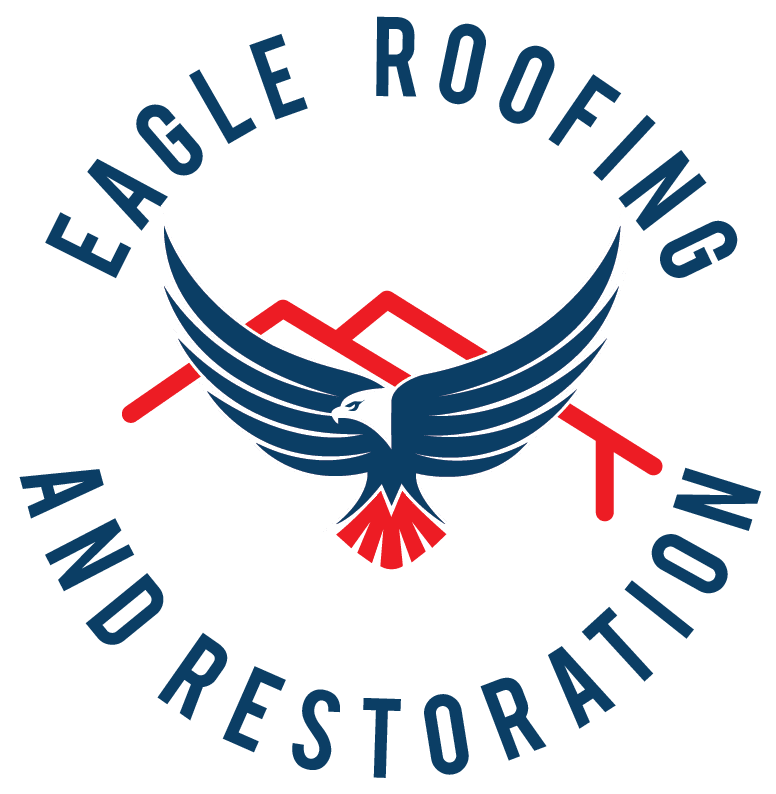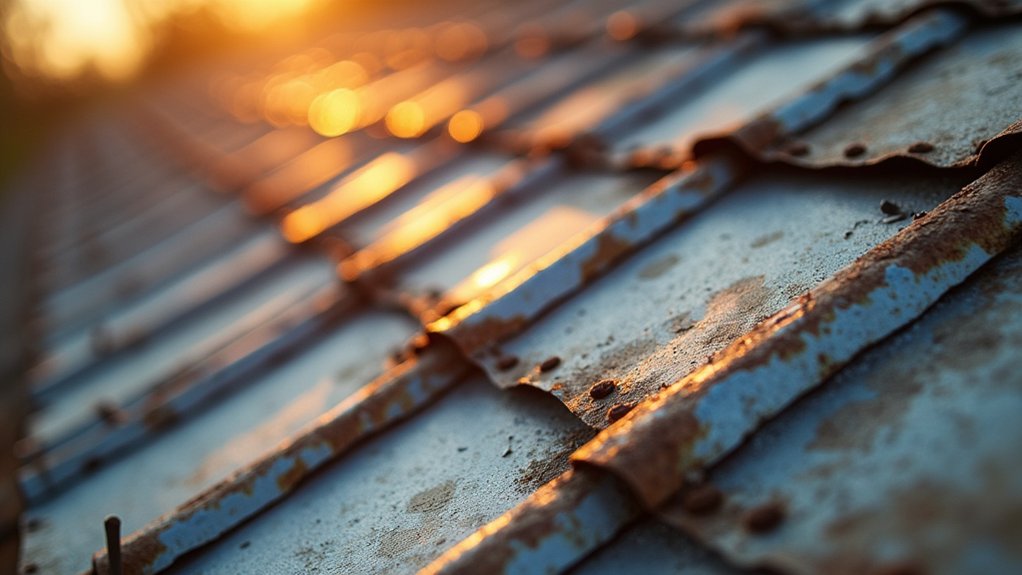Your metal roof’s lifespan will vary based on the specific material you choose, with most lasting 40-70+ years when properly installed and maintained. Aluminum roofs typically endure 50+ years, while premium options like copper and zinc can exceed 70 years of service. Regular maintenance, including bi-annual inspections and prompt repairs, greatly extends longevity. Climate conditions and installation quality play pivotal roles in determining your roof’s actual performance let’s explore what impacts its durability most.
The Lifespan of Different Metal Roofing Materials
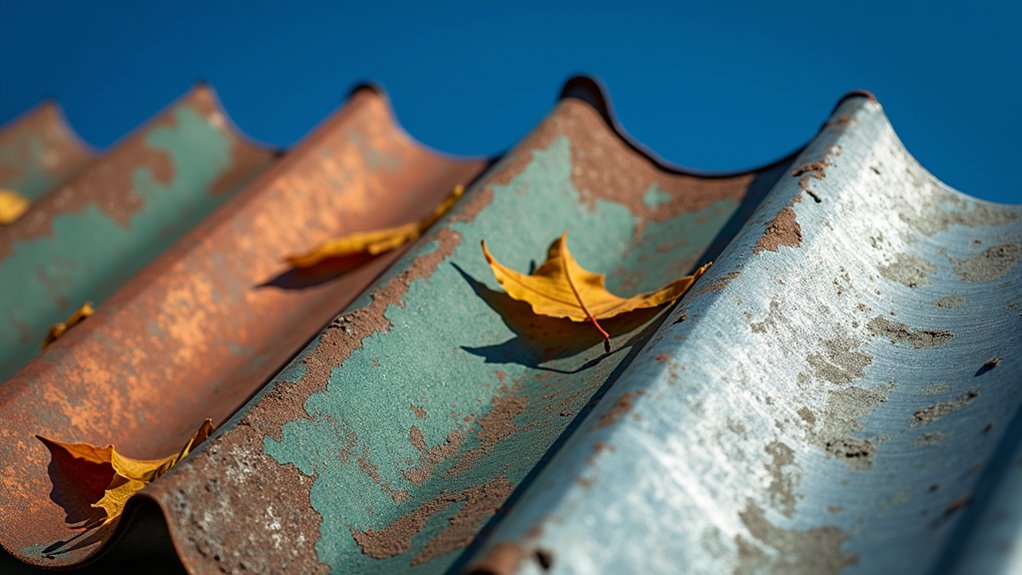
While traditional asphalt shingles typically last 20-25 years, metal roofing materials offer considerably longer lifespans ranging from 40-70+ years depending on the specific metal used. You’ll find that aluminum roofing systems can last 50+ years, while zinc roofs often exceed 60 years when properly maintained.
Steel roofing’s durability varies based on its alloy composition and metal thickness. Galvanized steel typically lasts 40-60 years, while Galvalume steel can extend to 60+ years. Premium metals like copper and zinc offer exceptional longevity, often lasting 70+ years and developing an attractive patina over time.
The key factors affecting metal roof longevity include the gauge of the material, quality of protective coatings, and local climate conditions. You’ll get maximum lifespan by choosing appropriate metal thickness and proper installation methods.
Factors That Impact Metal Roof Longevity
While weather and climate exposure will greatly impact your metal roof’s durability through factors like UV radiation, extreme temperatures, and precipitation patterns, proper installation by qualified professionals remains equally essential for maximizing its lifespan. You’ll find that even the highest quality metal roofing materials can fail prematurely if installation techniques don’t follow manufacturer specifications and industry best practices. To protect your investment, you’ll need to maintain a regular inspection and maintenance schedule that addresses issues like sealant deterioration, fastener integrity, and surface damage before they compromise your roof’s performance.
Weather and Climate Exposure
Since weather and climate conditions directly impact metal roof performance, understanding your local environment is essential for forecasting longevity. Extreme temperature fluctuations cause metal panels to expand and contract, potentially stressing fasteners and seams over time. You’ll need to evaluate your region’s precipitation patterns, as frequent rain, snow, or ice can affect protective coatings and drainage systems.
Coastal areas present unique challenges due to salt spray exposure, which can accelerate corrosion if you don’t have proper protective finishes. High-wind regions require additional attention to panel attachment methods and structural support. You’ll also want to account for UV radiation intensity, as prolonged sun exposure can fade colors and degrade certain coating types. Areas with heavy snowfall need stronger gauge metal to handle increased load stress during winter months.
Installation Quality Matters
The quality of your metal roof installation directly determines its durability and performance potential. Even the highest-grade metal roofing materials won’t perform paramount without skilled workmanship during the installation process.
You’ll need experienced contractors who understand paramount installation methods, including proper fastening techniques, correct panel alignment, and appropriate underlayment application. They should also verify proper ventilation and account for thermal movement in the metal panels. Indispensable flashing installation around roof penetrations, valleys, and edges is vital for preventing water infiltration.
Poor installation practices can lead to premature failures, such as loose panels, water leaks, or structural issues. That’s why it’s indispensable to verify your contractor’s expertise with metal roofing systems and verify they follow manufacturer specifications precisely during the installation process.
Regular Maintenance Requirements
Despite metal roofs’ reputation for durability, regular maintenance remains essential for maximizing their lifespan. You’ll need to implement proper cleaning techniques and conduct seasonal inspections to prevent potential issues from escalating into costly repairs.
- Inspect your metal roof twice yearly, focusing on seams, fasteners, and flashings to identify loose components or early signs of corrosion.
- Remove debris, leaves, and branches promptly to prevent moisture accumulation and maintain proper drainage patterns.
- Clean your metal roof using appropriate non-abrasive cleaners and soft-bristled brushes to remove dirt, algae, or pollutants without damaging the protective coating.
When you notice any unusual wear patterns or concerning changes during maintenance, it’s indispensable to address them immediately. Professional inspections every few years can also help identify issues that might escape untrained eyes.
Maintenance Requirements for Maximum Durability
Maintaining your metal roof properly can extend its lifespan well beyond 50 years while preserving its structural integrity and appearance. To maximize durability, you’ll need to implement specific preventive measures, starting with annual inspections of all seams, fasteners, and flashings. You should address any loose components immediately to prevent water infiltration and structural damage.
Material preparation is vital when performing repairs. You’ll need to clean the affected areas thoroughly and use manufacturer-approved sealants and coatings. It is imperative to remove debris from valleys and gutters bi-annually, trim overhanging branches, and check for scratches or paint damage. When you spot surface oxidation, apply appropriate metal treatments to prevent corrosion. Professional inspections every three years can identify potential issues before they become major problems, ensuring your roof’s longevity.
Common Signs of Metal Roof Wear and Tear
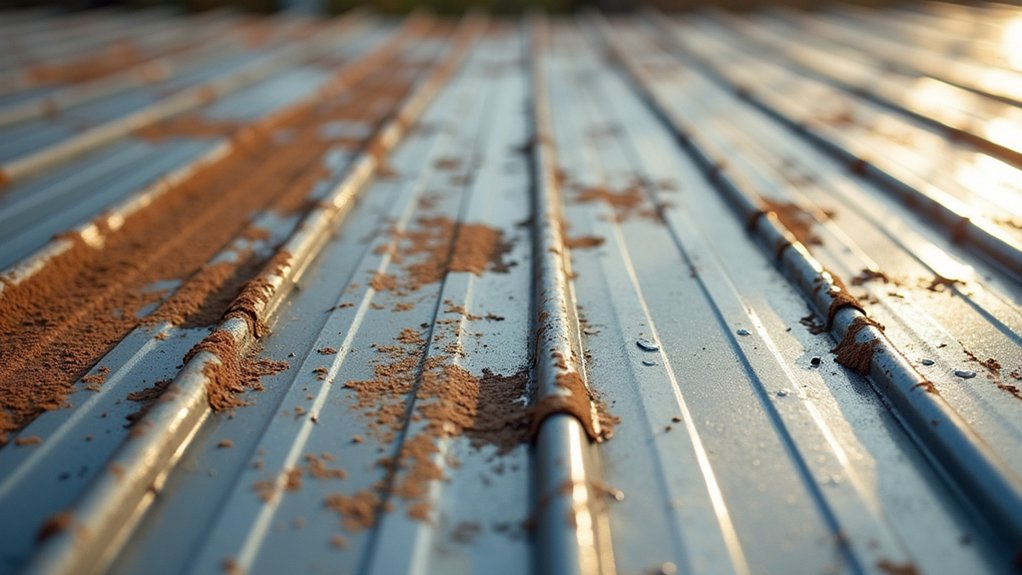
Several critical indicators can alert you to potential metal roof deterioration before serious damage occurs. You’ll need to monitor your metal roofing system regularly for these warning signs to prevent costly repairs and maintain its protective capabilities.
Regular inspection of metal roofing can catch early warning signs, helping prevent severe damage and maintain long-term protection.
- Visible corrosion patterns often appear first along seams and fastener points, indicating moisture infiltration or galvanic reactions between incompatible metals.
- Irregular surface discoloration that doesn’t match your roof’s natural weathering pattern can signal coating breakdown or chemical exposure from environmental pollutants.
- Structural issues like panel separation, loose fasteners, or warping might develop due to thermal expansion, wind stress, or improper installation.
Don’t ignore minor imperfections, as they can quickly escalate into major problems. When you spot these signs, it’s essential to consult a qualified metal roofing professional for proper assessment and repairs.
Weather Resistance and Environmental Performance
When properly installed, metal roofing systems demonstrate exceptional resilience against severe weather conditions and environmental stressors. You’ll find they provide superior UV radiation protection and maintain thermal insulation performance throughout extreme temperature variations.
| Weather Condition | Metal Roof Performance |
|---|---|
| Heavy Rain | Excellent water shedding |
| High Winds | Resistant up to 140mph |
| Snow/Ice | Prevents ice dam formation |
| Hail Impact | Class 4 impact resistance |
Your metal roof’s protective coating reflects solar radiation, reducing cooling costs in summer months. The interlocking panel design creates a barrier against wind-driven rain and prevents moisture infiltration. Unlike traditional roofing materials, metal systems won’t crack, split, or deteriorate from prolonged sun exposure. They maintain structural integrity during freeze-thaw cycles and resist damage from falling branches or debris.
Cost vs. Durability: A Long-Term Investment Analysis
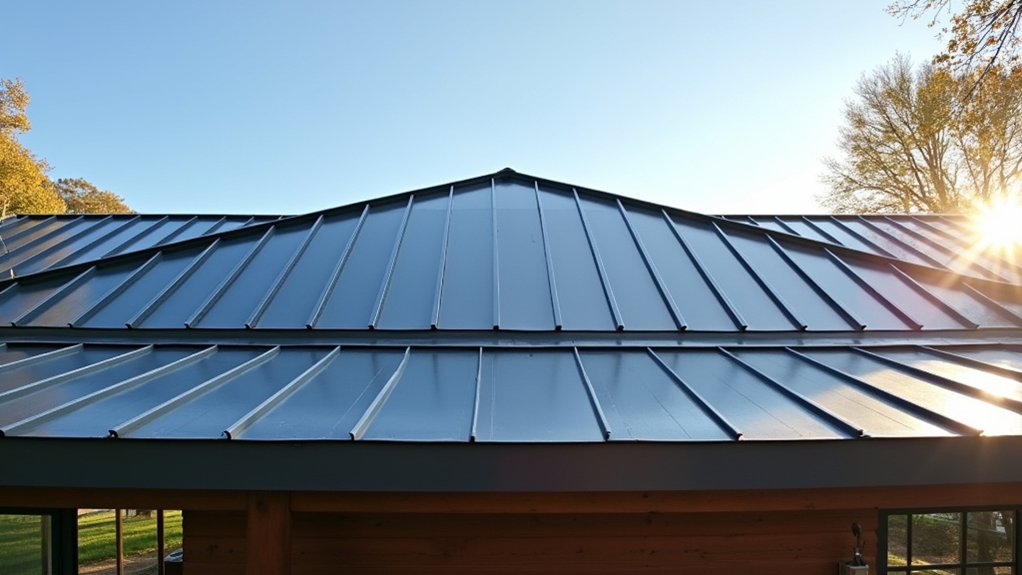
While you’ll face higher upfront costs when installing a metal roof compared to traditional asphalt shingles, your investment typically pays off through the roof’s 40-60 year lifespan. You’ll recover costs through reduced maintenance needs, lower insurance premiums, and increased home value, with metal roofs offering a return on investment of up to 95% at resale. The minimal maintenance requirements of metal roofing primarily periodic inspections and occasional resealing stand in stark contrast to the frequent repairs and replacements needed for conventional roofing materials.
Initial Installation Costs
Although metal roofing carries a higher upfront cost compared to traditional asphalt shingles, its exceptional durability and longevity make it a financially sound investment. The initial investment typically ranges from $8-$16 per square foot installed, with material costs varying based on metal type and finish quality.
When calculating your installation budget, consider these essential cost factors:
- Metal panel type and gauge thickness – premium metals like copper and zinc command higher prices than steel or aluminum
- Specialized labor requirements – skilled installers with metal roofing expertise typically charge more than general roofers
- Additional structural requirements – your roof deck may need reinforcement to support the metal system’s weight
While these upfront expenses are significant, you’ll benefit from reduced maintenance costs and a roof that can last 50+ years.
Return on Investment Analysis
The long-term financial benefits of metal roofing become clear through a detailed return on investment analysis. While you’ll face higher upfront costs, metal roofs typically deliver significant long-term savings through their 40-60 year lifespan, compared to traditional asphalt shingles that require replacement every 15-20 years.
Your payback period usually ranges from 10-15 years, factoring in reduced maintenance costs, lower insurance premiums, and enhanced energy efficiency. You’ll save approximately 25% annually on cooling costs due to metal’s superior heat reflection properties. When you calculate the expense of multiple asphalt roof replacements against a single metal roof installation, you’ll find that metal roofing’s durability translates to substantial financial advantages, especially if you plan to stay in your home long-term.
Maintenance Cost Comparison
Comparing maintenance costs between metal and traditional roofing materials reveals significant long-term savings potential. While you’ll face higher upfront costs with metal roofing, the repair cost comparison over decades shows substantial advantages.
- Traditional asphalt shingles require maintenance every 3-5 years, costing $300-$500 per repair, plus complete replacement every 15-20 years at $8,000-$15,000
- Metal roofs need minimal maintenance every 10-15 years, with average repair costs of $200-$300, and rarely require full replacement within 50+ years
- Your replacement options with metal roofing often involve simple panel fixes rather than extensive overhauls, saving 60-75% on long-term maintenance expenses
When factoring in longevity and durability, metal roofing’s maintenance costs average just $0.20 per square foot annually compared to asphalt’s $0.85 per square foot.
Professional Installation’s Role in Roof Longevity
Professional installation profoundly impacts your metal roof’s longevity, serving as a critical factor in maximizing its service life. Skilled workmanship guarantees proper panel alignment, secure fastening, and appropriate flashing installation, which prevents water infiltration and structural issues. You’ll need to verify that your contractor obtains necessary permits and adheres to local building codes.
When you select a certified installer, they’ll implement proper ventilation systems, use compatible materials, and maintain precise measurements for ideal performance. They’ll also account for thermal expansion, install appropriate underlayment, and assure correct overlap of panels. Their expertise helps prevent common installation errors that could lead to premature failure, such as improper seam closure or incorrect fastener placement. Professional installation ultimately protects your investment and helps achieve the roof’s full lifespan potential.
Metal Roofing Warranties and Coverage
Metal roofing warranties complement professional installation by providing long-term protection for your investment. You’ll typically find extensive warranty coverage that safeguards against manufacturing defects, material failures, and performance issues. Manufacturer support often includes technical assistance and replacement materials when needed.
When evaluating metal roofing warranties, consider these critical elements:
- Length of coverage – premium metal roofs often carry warranties ranging from 30 to 50 years, with some offering lifetime protection
- Transferability – many warranties can transfer to subsequent property owners, enhancing your home’s resale value
- Scope of protection – look for coverage that includes material defects, finish integrity, and weathering resistance
Comprehending your warranty’s terms and maintaining proper documentation guarantees you’ll receive full benefits if issues arise during the covered period.
Comparing Metal Roof Lifespans to Other Materials
Most traditional roofing materials fall considerably short of metal’s impressive 40-70 year lifespan. Asphalt shingles, which dominate residential roofing, typically last only 15-30 years before requiring replacement. Wood shakes offer 20-25 years of service, while slate can endure 50+ years but comes with significant structural requirements due to its weight.
The material composition of metal roofing provides superior durability against weather extremes, UV exposure, and pest damage. You’ll find that metal’s environmental impact is substantially lower than other options, as it’s both recyclable and often contains recycled content. While concrete tiles can last 50 years, they’re prone to cracking and moisture penetration. When you compare maintenance requirements, you’ll discover that metal roofs need minimal upkeep compared to traditional materials that demand regular repairs and replacements.
Tips for Extending Your Metal Roof’s Life
To maximize your metal roof’s longevity, you’ll need to schedule professional inspections at least annually to catch potential issues before they escalate. You’ll want to maintain proper drainage by keeping gutters clear and ensuring water flows freely off the roof’s surface without pooling. Protecting against rust formation through prompt touch-up painting of scratches and maintaining the roof’s protective coating will vastly/greatly/considerably extend your metal roof’s service life.
Regular Professional Inspections
While DIY maintenance plays an important role, scheduling professional roof inspections every 1-2 years remains pivotal for maximizing your metal roof’s lifespan. Regular inspection scheduling helps identify potential issues before they escalate into costly repairs, making it one of the most cost-effective inspection methods available.
Professional inspectors will thoroughly examine your metal roof using specialized equipment and expertise to:
- Detect early signs of corrosion, loose fasteners, or compromised seams that might be invisible to untrained eyes
- Assess the integrity of flashings, valleys, and junctions where water infiltration commonly occurs
- Document the roof’s condition with detailed reports and thermal imaging, enabling you to track changes over time
Consider coordinating these inspections with your regular maintenance schedule to streamline the process and maintain your warranty requirements.
Proper Drainage Maintenance
Maintaining proper drainage systems on your metal roof represents a critical factor in preventing water damage and extending its service life. You’ll need to perform regular gutter cleaning to remove leaves, twigs, and debris that can obstruct water flow and create damaging backups.
Schedule drainage system inspections at least twice yearly, focusing on gutters, downspouts, and valleys where water tends to collect. Check for proper slope and alignment to guarantee water flows efficiently away from your roof’s surface. You’ll want to verify that all drainage components remain securely fastened and free from rust or deterioration.
If you notice standing water, slow drainage, or overflow during rainfall, address these issues immediately. Install gutter guards to reduce debris accumulation and maintain consistent water flow throughout your roof’s drainage network.
Prevent Rust Formation
Beyond drainage concerns, rust formation poses a significant threat to metal roofing systems. To maximize your roof’s lifespan, you’ll need to implement strategic measures for galvanic corrosion prevention and electrochemical corrosion mitigation. Regular inspection and maintenance are vital to identify potential rust issues before they escalate.
- Apply a protective coating or sealant specifically designed for metal roofing every 3-5 years, focusing on areas where different metals meet to prevent galvanic reactions.
- Install proper isolation materials between dissimilar metals and guarantee all fasteners are compatible with your roof’s metal type to avoid electrochemical corrosion.
- Address any scratches, dings, or exposed metal promptly by cleaning the affected area and applying touch-up paint or rust-inhibiting primer to maintain the protective barrier.
Frequently Asked Questions
Can Metal Roofing Be Installed Over Existing Shingles?
Yes, you can install metal roofing over existing shingles, but the existing roof condition must meet specific installation requirements first. You’ll need to guarantee the current roof deck is solid, free from rot, and structurally sound. Local building codes might require a tear-off, so check your regulations. If approved, you’ll need to install a proper underlayment between the shingles and metal panels to prevent moisture issues and secure proper ventilation.
Does Metal Roofing Make Your House Hotter in Summer?
Contrary to common belief, metal roofing won’t make your house hotter in summer. In fact, it reflects heat effectively, helping to maintain comfortable indoor temperatures. Your metal roof acts as a barrier against solar heat gain, especially when properly installed with adequate ventilation and insulation. You’ll find that metal roofing systems can reduce cooling costs by up to 25% compared to traditional asphalt shingles, as they reflect rather than absorb solar radiation.
What Colors Are Available for Metal Roofing?
You’ll find an extensive range of color options for metal roofing, from traditional to contemporary choices. Most manufacturers offer a variety of metallic finishes, including galvanized, aluminum, copper, and zinc, each with its distinct appearance. You can select from standard colors like charcoal, forest green, and burgundy, or opt for customizable color options to match your home’s aesthetic. Many finishes also feature special coatings that enhance durability and solar reflectivity.
Is Metal Roofing Noisy During Rain and Hailstorms?
You’ll find that modern metal roofing isn’t as noisy as you might expect. When properly installed with solid decking, underlayment, and insulation properties, metal roofs can be just as quiet as traditional asphalt shingles during rain or hail. The layered construction system provides excellent temperature regulation and sound dampening. Your attic’s insulation and the roof’s installation method play essential/pivotal/central roles in noise reduction, making today’s metal roofs a comfortable choice for any home.
Can I Walk on My Metal Roof to Clean Gutters?
You can walk on your metal roof, but you’ll need to take proper precautions. Always wear soft-soled shoes, walk on the panel’s flat areas near structural supports, and avoid excessive walking to prevent damage or denting. To minimize the need for gutter maintenance, consider installing gutter guards. If you’re not confident about roof safety, it’s best to hire a professional who knows the correct techniques for traversing metal roofing systems.
